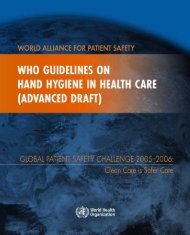Adverse event reporting.pdf
Adverse event reporting.pdf
Adverse event reporting.pdf
You also want an ePaper? Increase the reach of your titles
YUMPU automatically turns print PDFs into web optimized ePapers that Google loves.
Responsive. For recommendations to result in widespread systems changes, the<br />
organization receiving reports must be capable of making and disseminating effective<br />
recommendations, and target organizations must make a commitment to<br />
implement recommendations. A good example is the National Reporting and<br />
Learning System in England and Wales which allows the National Patient Safety<br />
Agency to develop new solutions that are disseminated throughout the system.<br />
Several of these characteristics are<br />
included among the attributes that<br />
Runciman has proposed for national<br />
Reporters are free from fear of retaliation against themselves<br />
or punishment of others as a result of <strong>reporting</strong>.<br />
• an independent organization<br />
The identities of the patient, reporter, and institution are to coordinate patient safety<br />
never revealed.<br />
surveillance;<br />
The <strong>reporting</strong> system is independent of any authority • agreed frameworks for patient<br />
with power to punish the reporter or the organization.<br />
safety and surveillance systems;<br />
Reports are evaluated by experts who understand the • common, agreed standards and<br />
clinical circumstances and are trained to recognize un-<br />
terminology;<br />
derlying systems causes.<br />
• a single, clinically useful<br />
Reports are analysed promptly and recommendations classification for things that go<br />
are rapidly disseminated to those who need to know, es-<br />
wrong in health care;<br />
pecially when serious hazards are identified.<br />
• a national repository for<br />
Recommendations focus on changes in systems, process-<br />
information covering all of<br />
es, or products, rather than being targeted at individual health care from all available<br />
performance.<br />
sources;<br />
The agency that receives reports is capable of dissemi-<br />
• mechanisms for setting<br />
nating recommendations. Participating organizations<br />
priorities at local, national and<br />
commit to implementing recommendations whenever<br />
<strong>reporting</strong> and learning systems (6):<br />
international levels;<br />
possible.<br />
• a just system which caters for<br />
the rights of patients, society,<br />
and health-care practitioners and facilities;<br />
• separate processes for accountability and “systems learnings”;<br />
• the right to anonymity and legal privilege for reporters;<br />
• systems for rapid feedback and evidence of action;<br />
• mechanisms for involving and informing all stakeholders.<br />
Table 1 Characteristics of Successful Reporting Systems (7)<br />
Non-punitive<br />
Confidential<br />
Independent<br />
Expert analysis<br />
Timely<br />
Systems-oriented<br />
Responsive
















